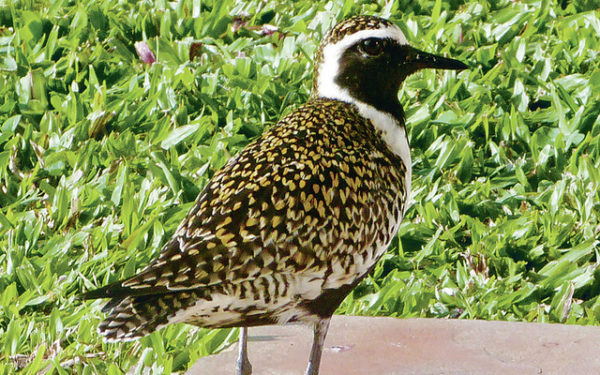Published in the Ocean Watch column, Honolulu Star-Advertiser © Susan Scott
April 25, 2016
The past few weeks our Pacific golden plovers, or kolea as we call them here in Hawaii, have looked so stunning in their spring attire, I’ve often had to stop and stare. Now it’s time to say farewell.
I wish they wouldn’t go, but that’s migration for you. The birds have molted into their breeding colors not to charm us, but to charm a mate in Alaska, where with luck the couple will raise four chicks.
 This bird’s black face, ringed with white, marks it as a male.
This bird’s black face, ringed with white, marks it as a male.
He is due to take off any day now for Alaska, where he’ll try to woo a mate.
©2016 Susan Scott
So off they go today (or within the next few days), 7-ounce birds flying 3,000 miles nonstop over the Pacific Ocean in three days.
This winter we had a kolea we called “she” occasionally hop onto our lanai from the fronting golf course. Now our lanai visitor is a male. He’s plump, perky and drop-dead gorgeous. “Did that female ever come back?” Craig asked last week as we admired the preening male.
She didn’t. But now that I think about it, our winter “she” is probably the spring “he” we’re seeing now, the same bird dressed in different outfits. The golf course is loaded with plovers, but because the species is territorial, it’s likely the same bird.
When we see kolea in parks, on golf courses and along roads in winter, there’s no way to know whether they’re males or females.
The sexes look identical in winter, but come spring the difference between them is clear.
Males have solid black faces, breasts and bellies, outlined by a bright white racing stripe. Females have similar colors, but they aren’t as sharply outlined, the result being a mottled look. Both sexes, though, have gold-flecked backs and wings that remind me of jeweled cloaks.
Healthy birds with enough body fat to make the journey generally leave Hawaii on or around April 25. The birds’ departure is dramatic. One day kolea are there. The next day they’re gone.
Don’t worry if your bird doesn’t leave this week. Each kolea knows whether it’s strong enough to make it to Alaska. A few underweight birds might skip the trip north and stay in Hawaii for the summer. These are often first-year birds that hatched the previous summer.
According to plover researcher Wally Johnson, no one knows how the birds coordinate their leaving. Over a few days the kolea gather in flocks of various sizes. Suddenly the flock takes off, rises to a great height and heads to sea until it disappears.
Sometimes an ascending flock merges with another passing by.
Johnson says a good place to see this flocking, and with luck, the departure itself, is Kualoa Regional Park on Kaneohe Bay.
Those of us who admire kolea fall, winter and spring feel their departure and absence acutely. But that’s the beauty of migration. In August they’ll be back.